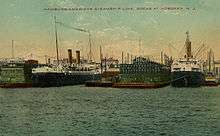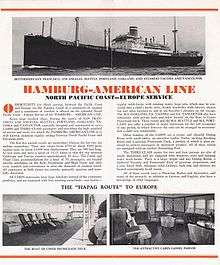Hamburg America Line
 HAPAG flag | |
Native name | Hamburg-Amerikanische Packetfahrt-Actien-Gesellschaft |
|---|---|
| Industry | shipping |
| Fate | Merged with Norddeutscher Lloyd |
| Successor | Hapag-Lloyd |
| Founded | 1847 |
| Founder | Albert Ballin (Director General), Adolph Godeffroy, Ferdinand Laeisz, Carl Woermann and August Bolten |
| Defunct | 1 September 1970 |
| Headquarters | Hamburg, Germany |
The Hamburg-Amerikanische Packetfahrt-Actien-Gesellschaft (HAPAG for short, often referred to in English as Hamburg America Line (sometimes also Hamburg-American Line, Hamburg-Amerika Linie or Hamburg Line); literally Hamburg American Packet-shipping Joint-stock company) was a transatlantic shipping enterprise established in Hamburg, Germany, in 1847. Among those involved in its development were prominent citizens such as Albert Ballin (Director General), Adolph Godeffroy, Ferdinand Laeisz, Carl Woermann, August Bolten and others, and its main financial backers were Berenberg Bank and H. J. Merck & Co. It soon developed into the largest German, and at times the world's largest, shipping company, serving the market created by the German immigration to the United States and later immigration from Eastern Europe. On 1 September 1970, after 123 years of independent existence, HAPAG merged with the Bremen-based North German Lloyd to form Hapag-Lloyd AG.
History
Ports served


In the early years, the Hamburg America Line exclusively connected European ports with North American ports, such as Hoboken, New Jersey, or New Orleans, Louisiana. With time, however, the company established lines to all continents. The company built a large ocean liner terminal at Cuxhaven, Germany, in 1900. Connected directly to Hamburg by a dedicated railway line and station, the HAPAG Terminal at Cuxhaven served as the major departure point for German and European immigrants to North America until 1969 when ocean liner travel ceased. Today it serves as a museum and cruise ship terminal.[1]
Notable journeys
In 1858, its liner Austria sank, killing 449 people. In 1891, the cruise of the Augusta Victoria in the Mediterranean and the Near East from 22 January to 22 March, with 241 passengers including Albert Ballin and wife, is often stated to have been the first passenger cruise. Christian Wilhelm Allers published an illustrated account of it as "Bakschisch". In 1897, its steamer Arcadia was wrecked on the rocks off Newfoundland.[2] In 1900, 1901 and 1903 its liner Deutschland won the Blue Riband taking the prize from the Kaiser Wilhelm der Grosse. In 1906 Prinzessin Victoria Luise ran aground off the coast of Jamaica. No lives were lost by the grounding; however, the ship's captain committed suicide after getting all the passengers safely off the ship.[3] In 1912, its liner SS Amerika was the first ship to warn Titanic of icebergs.
HAPAG's general director, Albert Ballin, believed that safety, size, comfort and luxury would always win out over speed. Thus he conceived the three largest liners yet to be built, named the Imperator, Vaterland and Bismarck. The first two were briefly in service before the First World War. In 1914, the Vaterland was caught in port at Hoboken, New Jersey at the outbreak of World War I and interned by the United States. She was seized, renamed Leviathan after the declaration of war on Germany in 1917, and served for the duration and beyond as a troopship. After the war, she was retained by the Americans in war reparations. In 1919 Vaterland's sister ships – Imperator and the unfinished Bismarck – were handed over to the allies as war reparations to Britain. They were sold to the Cunard Line and White Star Line respectively, and renamed Berengaria and Majestic. In 1917, its liner Allemannia was "torpedoed by German submarine near Alicante"; two people were lost.[4] In 1939, the HAPAG liner St. Louis was unable to find a port in Cuba, the United States, or Canada willing to accept the more than 950 Jewish refugees on board and had to return to Europe. On 9 April 1940, when German warships attacked Kristiansand, Norway, during Operation Weserübung (the opening assault of the Norwegian Campaign), the HAPAG freighter Seattle sailed into the crossfire between the warships and Norwegian coastal artillery. She was holed and sunk, and her crew briefly became prisoners of war.
Later years
The Hamburg America Line lost almost the entirety of its fleet twice, as a result of World War I and World War II. In 1970, the company merged with its longstanding rival, Norddeutscher Lloyd of Bremen, to establish the present-day company Hapag-Lloyd.
See also
References
- ↑ Hapag Halle Museum Cuxhaven
- ↑ "The Rescue by Rossmore". 26 May 1897.
- ↑ "Daily Event for December 16".
- ↑ "S/S Allemannia (3), Hamburg America Line". Norway-Heritage. Retrieved 2012-05-21.
External links
| Wikimedia Commons has media related to Hamburg-Amerikanische Packetfahrt-Actien-Gesellschaft. |
- Fleet information (in German)
- The history of the Hamburg-America Line
- Historic photos of Hoboken and Hamburg America Line ports
- Passenger Lists from the Hamburg-Amerika Linie
- Hamburg-Amerika Line ships This collection contains 16 photographs depicting ship interior and exterior views of Hamburg-Amerika Line's luxury passenger ships Augusta Victoria, Columbia and Normannia by Louis Koch, Bremen
- Documents and clippings about Hamburg America Line in the 20th Century Press Archives of the German National Library of Economics (ZBW)